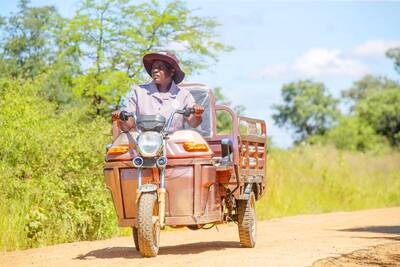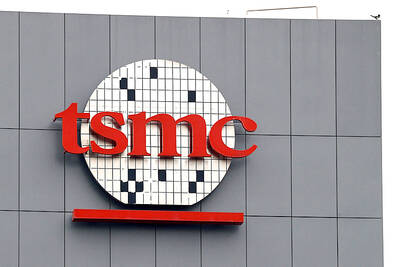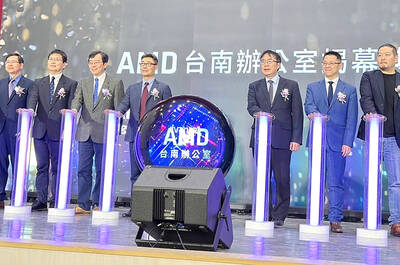When inventor Virginia Gardiner wanted to test-drive a toilet aimed at providing safe sanitation in the developing world, she knew just where to turn — a British music festival.
Her firm Loowatt, which turns waste into fertilizer and energy, is among a growing number of organizations using revelers at European summer festivals to trial products intended for humanitarian disaster zones or to cut energy use.
“It really, really puts the technology to the test,” said Gardiner, whose waterless toilets provide relief to British festival-goers and poor families in Madagascar without safe sewage systems.

Photo: Reuters
“It’s an environment that does test the ability of technologies to function, not only without your usual access to water or energy, but also in terms of their robustness,” she said.
Glastonbury — Britain’s best-known music and arts festival, held on a dairy farm in southwest England — opened on Wednesday, with campers arriving to pitch their tents ahead of headline performances by Stormzy, The Killers and The Cure.
The 2015 Glastonbury Festival was used to test a urinal for refugee camps that turns urine into electricity to power lights and charge phones.
The project, a collaboration between British building firm Dunster House, the University of the West of England, Bristol and charity Oxfam, is being piloted in African schools this year.
Another success story is the Semilla Sanitation Hub, which converts waste into drinking water and agricultural nutrients. It is now being used to help Kenyan farmers hit by climate change, with plans to roll it out into Jordanian refugee camps.
Industry experts say open-air, densely populated festivals create huge potential for innovation because — like refugee camps — tens of thousands of people suddenly arrive at a site that has to be built from scratch.
“If you are creating a temporary town ... obviously you need to bring new infrastructure into a place,” said Claire O’Neill from British-based non-profit group A Greener Festival, which assesses festivals on their environmental performance.
“It also provides an opportunity — you can then trial new ways of doing things,” she said.
The Netherlands Red Cross worked in 2017 with electronic music festival Mysteryland, near Amsterdam, to test wind turbines and mobile solar panels for use in refugee camps, said Juriaan Lahr, the society’s director of international operations.
“It’s important to maintain high standards when you are looking at the performance of new solutions,” he said.
“It is not always ethical or responsible to do it [testing] in the places where we work, because then we are dealing with people that are already exposed and vulnerable, who have already gone through a lot of suffering,” Lahr said.
While large aid agencies can often afford to role-play disaster responses, the festival scene offers an alternative for small, impact-oriented companies without such deep pockets, said Mojtaba Salem, of the Research Institute on Leadership and Operations in Humanitarian Aid in Germany.
“In any kind of humanitarian operations, particularly the disaster relief, you have uncertainty and you have to deal with the logistical challenge, and these kinds of uncertain situations — you can find that in music festivals,” Salem said.
The potential of festivals as living labs for innovation inspired former start-up industry worker Anna van Nunen to cofound Dutch non-profit Innofest three years ago to help about 30 entrepreneurs test their products at 10 festivals each year.
Nine out of 10 innovations fail, often because a prototype has not been tested well enough, according to Innofest, which has worked with 90 innovations, from tents to energy and waste products, at Dutch music, theater and motorbike festivals.
Organizers were keen to harness their events for “greater societal purpose” by signing up for tests, Van Nunen said.
While about half of the products Innofest had tested would not be noticed by festival visitors, she said revelers had also been eager to participate when they were needed to help with trials.
Salem urged caution over how much information a successful festival trial could provide, but said that they offered real value and might become a fixture of the summer party scene.
“You should not 100 percent think that whatever works in the festival is going to work in the humanitarian sector because simply the extremity of the context is much higher and the uncertainty is also much higher, [but] there is definitely a discussion right now ... I think it will grow,” he said.

Anna Bhobho, a 31-year-old housewife from rural Zimbabwe, was once a silent observer in her home, excluded from financial and family decisionmaking in the deeply patriarchal society. Today, she is a driver of change in her village, thanks to an electric tricycle she owns. In many parts of rural sub-Saharan Africa, women have long been excluded from mainstream economic activities such as operating public transportation. However, three-wheelers powered by green energy are reversing that trend, offering financial opportunities and a newfound sense of importance. “My husband now looks up to me to take care of a large chunk of expenses,

SECTOR LEADER: TSMC can increase capacity by as much as 20 percent or more in the advanced node part of the foundry market by 2030, an analyst said Taiwan Semiconductor Manufacturing Co (TSMC, 台積電) is expected to lead its peers in the advanced 2-nanometer process technology, despite competition from Samsung Electronics Co and Intel Corp, TrendForce Corp analyst Joanne Chiao (喬安) said. TSMC’s sophisticated products and its large production scale are expected to allow the company to continue dominating the global 2-nanometer process market this year, Chiao said. The world’s largest contract chipmaker is scheduled to begin mass production of chips made on the 2-nanometer process in its Hsinchu fab in the second half of this year. It would also hold a ceremony on Monday next week to

TECH CLUSTER: The US company’s new office is in the Shalun Smart Green Energy Science City, a new AI industry base and cybersecurity hub in southern Taiwan US chip designer Advanced Micro Devices Inc (AMD) yesterday launched an office in Tainan’s Gueiren District (歸仁), marking a significant milestone in the development of southern Taiwan’s artificial intelligence (AI) industry, the Tainan City Government said in a statement. AMD Taiwan general manager Vincent Chern (陳民皓) presided over the opening ceremony for the company’s new office at the Shalun Smart Green Energy Science City (沙崙智慧綠能科學城), a new AI industry base and cybersecurity hub in southern Taiwan. Facilities in the new office include an information processing center, and a research and development (R&D) center, the Tainan Economic Development Bureau said. The Ministry

ADVERSARIES: The new list includes 11 entities in China and one in Taiwan, which is a local branch of Chinese cloud computing firm Inspur Group The US added dozens of entities to a trade blacklist on Tuesday, the US Department of Commerce said, in part to disrupt Beijing’s artificial intelligence (AI) and advanced computing capabilities. The action affects 80 entities from countries including China, the United Arab Emirates and Iran, with the commerce department citing their “activities contrary to US national security and foreign policy.” Those added to the “entity list” are restricted from obtaining US items and technologies without government authorization. “We will not allow adversaries to exploit American technology to bolster their own militaries and threaten American lives,” US Secretary of Commerce Howard Lutnick said. The entities